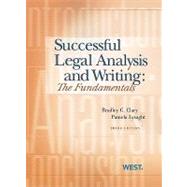
Note: Supplemental materials are not guaranteed with Rental or Used book purchases.
Purchase Benefits
What is included with this book?
| Preface | p. i |
| Road Mapping | p. 1 |
| Where, What | p. 2 |
| Why | p. 2 |
| Who | p. 2 |
| When | p. 3 |
| How | p. 3 |
| Example | p. 4 |
| Comparison to Legal Writing | p. 7 |
| The Role of Facts in Resolving Legal Problems | p. 11 |
| Story Identification | p. 12 |
| Additional Story Identification Principles | p. 16 |
| The Role of Rules in Resolving Legal Problems | p. 19 |
| The Sources of Rules: Enacted Law and Cases | p. 19 |
| Enacted Law | p. 20 |
| Cases | p. 23 |
| Basic Principles for Understanding Primary Authority | p. 25 |
| Considerations When Working with Statutes and Cases | p. 28 |
| Determining the Rule in Typical, Simple Scenarios | p. 31 |
| Pulling Apart a Rule | p. 31 |
| Common Mistakes in Parsing a Rule | p. 35 |
| Assembling a Rule from a Single Court Decision | p. 38 |
| Determining the Rule in Typical, Complex Scenarios | p. 47 |
| Assembling a Rule from Multiple Court Decisions | p. 47 |
| Common Mistakes in Assembling a Rule from Multiple Cases | p. 59 |
| Determining the Rule in Atypical Scenarios | p. 61 |
| Assembling Rules in Atypical Settings: Direct Conflicts | p. 61 |
| Assembling Rules in Atypical Settings: Cases of First Impression | p. 65 |
| Determining the Meaning of a Statutory Rule | p. 71 |
| Interpreting Statutory Language | p. 71 |
| Understand Issues of Statutory Interpretation in Context | p. 73 |
| Basic Organizing Principles in Legal Analysis and Writing | p. 81 |
| IRAC: The Basic Components | p. 84 |
| Introduction | p. 84 |
| Rule | p. 86 |
| Application | p. 88 |
| Conclusion | p. 91 |
| Linking Discrete IRACs | p. 91 |
| Basic Writing Principles | p. 97 |
| Prefer Simplicity | p. 98 |
| Prefer the Familiar | p. 98 |
| Prefer Concision | p. 98 |
| Prefer Action | p. 99 |
| Avoid Overuse of Adjectives and Adverbs | p. 100 |
| Pay Attention to Flow | p. 100 |
| Be Meticulous | p. 101 |
| Common Mistakes to Avoid | p. 101 |
| Citation and Quotation Basics | p. 103 |
| ALWD Citation Manual | p. 105 |
| General Citation Rules | p. 105 |
| Full and Short Citations | p. 105 |
| Pinpoint References | p. 106 |
| Citation Placement and Use | p. 106 |
| Abbreviations | p. 107 |
| Capitalization | p. 110 |
| Citing to Primary Authority | p. 110 |
| Constitutions currently in force | p. 110 |
| Statutes currently in force | p. 110 |
| Cases | p. 113 |
| Citing to Secondary Authority | p. 115 |
| Restatements | p. 115 |
| Legal Periodicals (Law Reviews) | p. 116 |
| Books | p. 117 |
| Working with Signals | p. 118 |
| The Bluebook | p. 120 |
| General Citation Rules | p. 120 |
| Full and Short Citations | p. 120 |
| Pinpoint References | p. 121 |
| Citation Placement and Use | p. 121 |
| Abbreviations | p. 122 |
| Capitalization | p. 125 |
| Citing to Primary Authority | p. 125 |
| Constitutions currently in force | p. 125 |
| Statutes currently in force | p. 126 |
| Cases | p. 128 |
| Citing to Secondary Authority | p. 130 |
| Restatements | p. 130 |
| Legal Periodicals (Law Reviews) | p. 131 |
| Books | p. 132 |
| Working with Signals | p. 133 |
| General Rules on Quoting Authority | p. 135 |
| Block Quotations | p. 135 |
| Shorter Quotations | p. 136 |
| Alterations and Omissions | p. 136 |
| Common Questions about When and What to Cite | p. 139 |
| Communicating a Predictive Analysis | p. 143 |
| Common Features of Good Predictive Writing | p. 144 |
| The Office Memorandum Template | p. 151 |
| The Client Advice Letter Template | p. 172 |
| Communicating a Persuasive Analysis | p. 185 |
| Common Features of Good Persuasive Writing | p. 186 |
| The Trial Court Brief Template | p. 191 |
| The Appellate Brief Template | p. 236 |
| Oral Argument | p. 261 |
| A Way to Prepare the Argument | p. 261 |
| A Way to Begin the Argument | p. 263 |
| A Way to Approach the Middle of the Argument | p. 265 |
| A Way to Approach the Conclusion of the Argument | p. 269 |
| Table of Contents provided by Ingram. All Rights Reserved. |
The New copy of this book will include any supplemental materials advertised. Please check the title of the book to determine if it should include any access cards, study guides, lab manuals, CDs, etc.
The Used, Rental and eBook copies of this book are not guaranteed to include any supplemental materials. Typically, only the book itself is included. This is true even if the title states it includes any access cards, study guides, lab manuals, CDs, etc.